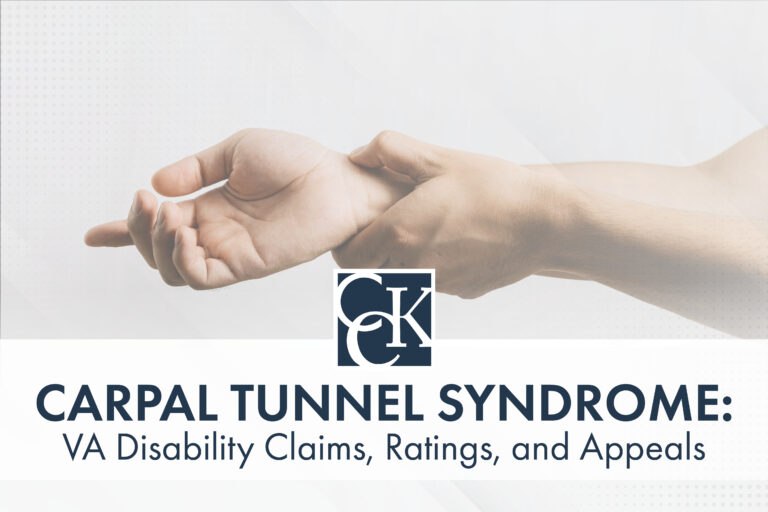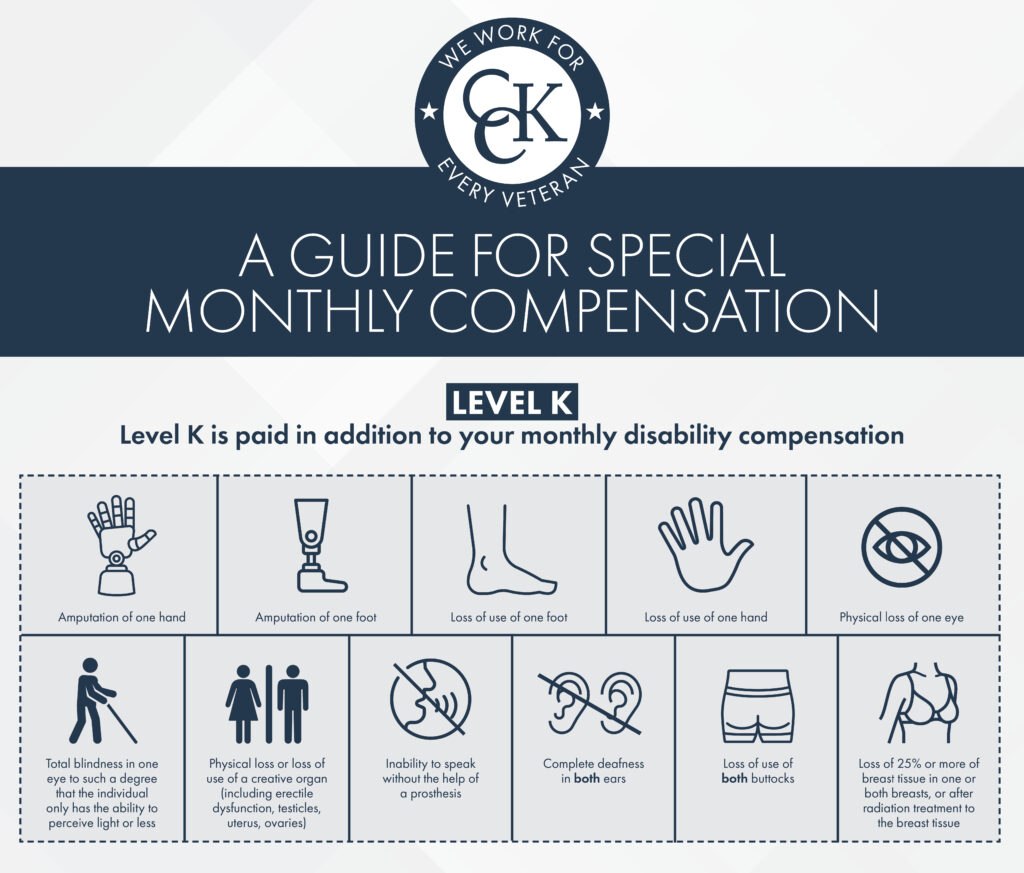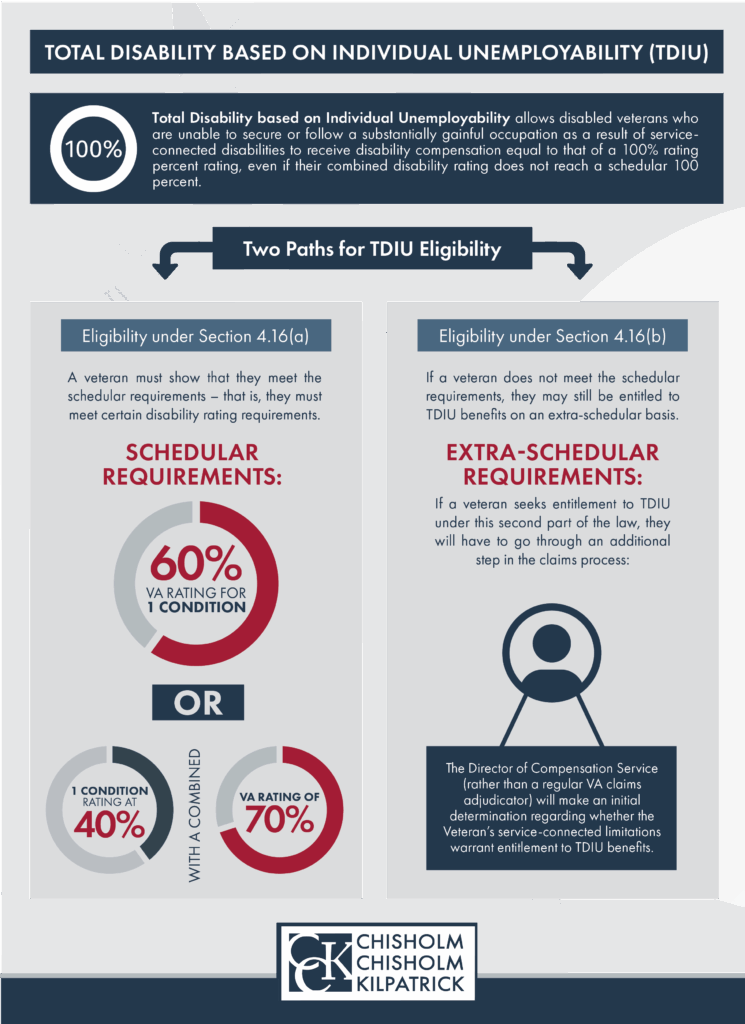Carpal Tunnel Syndrome: VA Disability Claims, Ratings, and Appeals

CCK Law: Our Vital Role in Veterans Law
Carpal tunnel, or carpal tunnel syndrome (CTS), is a common condition that typically involves pain, numbness, tingling, and weakness in a person’s hand and arm. Carpal tunnel has a higher incidence rate among veterans than in the civilian population, possibly because of the repetitive and manual nature of many military occupations.
If you are a veteran suffering from CTS, then you may be eligible for compensation from VA to help you handle your condition, so long as you can prove your carpal tunnel is service connected.
While VA ratings for carpal tunnel are typically not high—the most common rating is 10 percent—there are ways that veterans can increase their carpal tunnel rating or combine it with other VA ratings for additional VA benefits.
This article will discuss:
- How to prove carpal tunnel syndrome and get service connection for your VA disability claim
- What VA disability ratings and benefits exist for carpal tunnel syndrome
- How to increase a VA disability rating for carpal tunnel

What is Carpal Tunnel Syndrome?
Understanding carpal tunnel syndrome can help you prove your claim.
Carpal tunnel syndrome occurs when the median nerve, one of the major nerves to the hand, is squeezed or compressed as it travels through the carpal tunnel—a narrow passageway—in the wrist.
Because the median nerve helps move the fingers, hand, forearm, and wrist, carpal tunnel syndrome can cause a wide range of painful symptoms that may limit the range of motion and make it difficult to work.
Symptoms of Carpal Tunnel Syndrome
The symptoms of carpal tunnel syndrome vary from person to person. However, the most common symptoms include:
- Weakness in one or both hands that makes it difficult to grip objects
- A feeling of “pins and needles” in the fingers
- Wrist pain
- Pain or numbness in the hands
- A swollen sensation in the fingers
- Burning or tingling in the fingers, especially the thumb
- Pain or numbness that gets worse at night
Causes of Carpal Tunnel Syndrome
Common risk factors include:
- Hereditary traits: There may be anatomic differences that change the amount of space for the median nerve, resulting in a higher chance of compression. These traits can run in families.
- Repetitive hand use: Repetitive motion of the hand and wrist over a prolonged period may aggravate the tendons in the wrist, causing swelling that puts pressure on the nerve.
- Hand and wrist position: Doing activities that involve extreme flexion or extension (bending) of the hand and wrist for a prolonged period can increase pressure on the nerve.
- Other health conditions: Diabetes, rheumatoid arthritis, and thyroid gland imbalance are conditions that may cause carpal tunnel.
Prognosis for Carpal Tunnel Syndrome
If treated promptly, the symptoms of carpal tunnel syndrome can sometimes be reduced. For example, taking breaks, avoiding irritating activities, and using cold packs can reduce symptoms in mild cases. For more advanced conditions, doctors may use drugs, splints, and endoscopic surgery to take pressure off the median nerve.
Note that a lack of symptoms may increase the likelihood that VA denies or reduces a disability rating for carpal tunnel. Keeping careful records of symptoms and treatments can help prove carpal tunnel despite temporary improvements in symptoms.
How to Establish Service Connection for Carpal Tunnel
To receive VA disability benefits for carpal tunnel syndrome, you must first prove to VA that your carpal tunnel condition is a result of your time in service or that your pre-existing case of carpal tunnel was made worse by service. This is referred to as “service connection.”
Direct Service Connection for Carpal Tunnel Syndrome
A direct service connection is when you can prove that your carpal tunnel is a direct result of or was aggravated by your military service. To establish direct service connection, you must prove all of the following:
- A current diagnosis of carpal tunnel;
- An in-service event, injury, or illness (e.g., a role involving repetitive hand movements); and
- A medical nexus (i.e., link) between the current diagnosis and the in-service event, injury, or illness.
There are a variety of forms of evidence that you can use to support a carpal tunnel claim. In addition to service records and medical evidence, you may also provide supporting evidence like buddy statements and symptom logs.
The third element of direct service connection related to a medical nexus may require obtaining an opinion from a VA healthcare professional or private physician. Ideally, the medical opinion will explicitly state that your carpal tunnel is “at least as likely as not” related to your military service.
Secondary Service Connection for Carpal Tunnel Syndrome
Service connection can also be established on a secondary basis. If you already had a service-connected condition, and it caused or aggravated your carpal tunnel, you may now qualify for VA disability benefits for CTS as well.
Some conditions that may lead to carpal tunnel syndrome are diabetes, hypothyroidism, rheumatoid arthritis, osteoarthritis, acromegaly, sarcoidosis, and amyloid infiltration of the transverse carpal ligament.
Carpal tunnel syndrome may also lead to additional disabilities. If you are service connected for carpal tunnel, all disabilities that develop post-service due to your carpal tunnel are now also eligible for compensation. This can increase your combined VA rating and thus your benefits.
To prove secondary service connection, you must provide evidence connecting the conditions, typically from a medical professional.

VA Disability Ratings for Carpal Tunnel Syndrome
VA disability compensation is based on the rating that VA assigns after acknowledging service connection.
A carpal tunnel VA rating uses criteria found in 38 CFR § 4.124a, Schedule of Ratings—Neurological conditions and convulsive disorders, Diagnostic Code 8515. The rating criteria are based on the degree of paralysis of the median nerve.
(dominant hand/non-dominant hand)
- 70/60 percent: complete paralysis: the hand inclined to the ulnar side, the index and middle fingers more extended than normally, considerable atrophy of the muscles of the thenar eminence, the thumb in the plane of the hand (ape hand); pronation incomplete and defective, absence of flexion of index finger and feeble flexion of middle finger, cannot make a fist, index and middle fingers remain extended; cannot flex distal phalanx of thumb, defective opposition and abduction of the thumb, at right angles to palm; flexion of wrist weakened; pain with trophic disturbances
- 50/40 percent: incomplete paralysis: severe
- 30/20 percent: incomplete paralysis: moderate
- 10/10 percent: incomplete paralysis: mild
Besides these basic criteria, several other factors may increase your VA rating for carpal tunnel.
Bilateral Carpal Tunnel Syndrome
If you have carpal tunnel in both hands, VA will assign ratings to both hands, combine them using a special formula (“VA math,” best calculated using an online disability calculator), and then add an additional 10 percent.
According to the official definition found in the Code of Federal Regulations (C.F.R.) § 4.26: “[when] a partial disability results from disease or injury of both arms, or of both legs, or of paired skeletal muscles, the ratings for the disabilities of the right and left sides will be combined as usual, and 10% of this value will be added before proceeding with further combinations.”
“Trigger Finger”
“Trigger finger” refers to a condition where you experience pain, stiffness, and a sensation of locking or catching when you bend and straighten your finger. The ring finger and thumb are most often affected by trigger finger, but the condition can also occur in the other fingers.
It is important to inform VA if you experience trigger finger, as it may be helpful to your claim.
VA Disability Compensation for Carpal Tunnel Syndrome
As of 2025, the VA disability rate benefit amounts are as follows:
- 0 percent disability rating: $0.00 per month
- 10 percent disability rating: $175.51 per month
- 20 percent disability rating: $346.95 per month
- 30 percent disability rating: $537.42 per month
- 40 percent disability rating: $774.16 per month
- 50 percent disability rating: $1,102.04 per month
- 60 percent disability rating: $1,395.93 per month
- 70 percent disability rating: $1,759.19 per month
- 80 percent disability rating: $2,044.89 per month
- 90 percent disability rating: $2,297.96 per month
- 100 percent disability rating: $3,831.30 per month
Besides monthly compensation, VA offers additional benefits for carpal tunnel syndrome and other service-connected disabilities.
Increasing VA Benefits for Carpal Tunnel Syndrome
The VA schedule of ratings may not always account for the actual impact of carpal tunnel syndrome on a veteran’s life or ability to work. Here are ways that veterans can request that VA increase disability rates and benefits for carpal tunnel.
Special Monthly Compensation for Carpal Tunnel Claims
You may qualify for VA special monthly compensation—SMC(k)—for “Loss of Use of a Hand” if your carpal tunnel condition leaves you with no effective remaining function in one or both of your hands.
SMC(k) provides an additional monthly dollar amount in addition to your regular rating. As of December 1, 2024, the additional monthly payment is $136.06.

Total Disability Based on Individual Unemployability (TDIU) for Carpal Tunnel
Carpal tunnel can affect your range of motion and your ability to lift, carry, reach, or grasp—all activities that are typically required in a workplace setting. For example, if you lack the dexterity or the ability to grasp, then you may not be able to type, operate a vehicle safely, or carry things in a warehouse or shipping department.
If you are unable to secure and maintain substantially gainful employment as a result of your service-connected carpal tunnel condition, you may be entitled to total disability based on individual unemployability (TDIU).

Carpal tunnel syndrome may qualify a veteran for schedular TDIU, combined schedular TDIU, or extraschedular TDIU.
- Schedular TDIU: To be eligible for “schedular” TDIU, a veteran must have either 1) a condition rated at least 60 percent, or 2) a combined rating of at least 70 percent and at least one rating of 40 percent or above.
- Extraschedular TDIU: Even if a veteran does not meet these conditions, they may still qualify for “extraschedular” TDIU if their carpal tunnel syndrome and any other specific service-connected conditions are preventing them from holding substantially gainful employment.
How to Appeal Your Carpal Tunnel Rating
There are various circumstances in which you may wish to revisit or appeal your carpal tunnel claim. For example:
- VA may have denied your claim incorrectly
- You believe your rating should be higher
- An existing condition may have worsened (note that carpal tunnel often grows worse over time)
- A secondary condition may have developed from your service-connected carpal tunnel
In situations like these, you do have options for appealing your rating.
Contact CCK Law Today
Appeals can be difficult and time sensitive. Also, veterans have likely already experienced lengthy delays while pursuing their original claim. Therefore, the law permits veterans to hire a VA-accredited law firm or advocate to assist with appeals.
For a free case evaluation from CCK Law, the leading and most experienced veterans law firm in the U.S., please call (800) 544-9144 or contact us online.
About the Author
Share this Post
